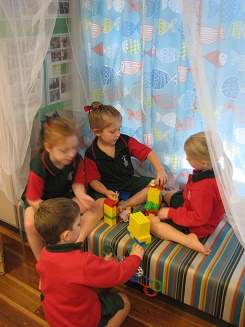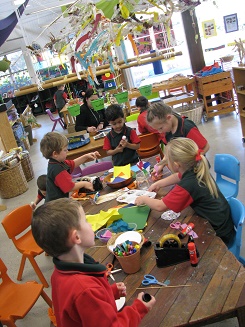When parents start to explore early education options for their toddler, they are confronted with a huge range of choices. Starting school can mean less parent involvement in day to day learning and more teacher structure – less play more work.
One north Brisbane school’s early learning program is changing those traditional perceptions by taking an innovative and different approach. The St Paul’s School Early Learning Centre’s Pre-Prep program has been inspired by the Reggio Emilia approach which is based on the belief that parents, teachers and children are equal stakeholders in the learning journey.
Reggio Emilia is an innovative program where the child is at the very centre of their learning. It values the child as strong, capable and resilient – rich with wonder and knowledge. It’s based on the belief that each child brings with them deep curiosity and potential that drives their interest to understand the world around them.
Learning Through Relationships
Reggio Emilia posits that children form an understanding of themselves and their place in the world through their interactions with others. There is a strong focus on social collaboration; working in groups, where each child is an equal participant; and having their thoughts, ideas and questions valued. The children search out knowledge through their own investigations and explorations. Children are encouraged to use language to investigate and explore, and to reflect on their experiences. Respect is a large component and strongly valued: children are listened to, acknowledged for their thoughts and ideas and seen as a contributor to the process of learning.
Child-initiated, Teacher-Framed Learning
The teacher is not viewed as the “giver” of knowledge but rather as a mentor and guide. Teachers observe, listen to their questions and stories, find out what interests them and then provide them with opportunities to explore further. That is, children’s thinking, understandings and relationships with others are highly valued and form the impetus for much of the learning that takes place. Rather than teachers following a predetermined curriculum, children’s individual or group interests and ideas form the basis of the learning projects that occur in the classrooms. Projects are ‘child initiated and teacher framed’.
For example, one teacher recently read a story depicting a full moon on the last page and this prompted a child to comment, “But I see different moons!” The same child drew a picture of a crescent moon on the whiteboard to illustrate his point and an ensuing group discussion prompted the question, “Why does the moon change?” What followed was an investigation by the children about the phases of the moon. The children observed the moon at home with their families, watched You Tube footage in the Early Learning Centre and conducted experiments set up by teachers to further develop their own understandings and prior knowledge about the phases of the moon.
When children and/or their families initiate projects, they become deeply involved in what is happening in the classroom. This approach awakens their confidence, interest and self-esteem. At any one time, numerous projects can be occurring in the Early Learning Centre, involving small and large groups or individuals. Other key projects have included everything from setting up an outdoor farm, an investigation into how the dinosaurs may have died, a Sushi Train restaurant and a puppet making project.
Environment as “Third Teacher”
Of great importance in a Reggio Emilia inspired program, is the learning environment, including the way spaces are organised, light and overall aesthetics. Along with the teacher and parent, the environment serves as a “third teacher”. Great value is placed on the provision of warm, family friendly, provocative and open ended learning spaces, where the children are tempted to discover and create and can self-select from a range of both natural and man-made resources. Materials set out for children both provoke new ideas and play, as well as build on children’s current interests. Both indoor and outdoor play areas allow children to explore and discover. Foundational literacy and numeracy concepts are embedded in the environment and there are always messy, busy spaces as well as couches and homely spaces where children can enjoy quiet time. This enables a great start to schooling where children can make a smooth and connected transition from home to school.
Tips for Introducing Reggio Emilia in the Home
- Discuss something your child is interested in (eg. dinosaurs, ballet, Japan). Ask them open questions about this subject. Try not to give answers. Instead, ask what they think. Get them to pose theories and answers.
- Ask your child to draw plans or ideas on this subject. Create a book of ideas, encourage curious questions and interesting observations.
- Take them on excursions. Go to the library to research ideas with your child, or the science centre, park or art gallery. Document their interests and ideas by taking photos and making a book, if you like.
- Create a stimulating environment. Create learning spaces in your home based on their interests which your child can help themselves to eg. home corner, dress ups, teepee/cubbyhouse, play dough/craft table, lego building etc
Marianne Connolly is the Head of Junior School at St Paul’s School, a K-12 co-educational private Anglican school based in north Brisbane. She holds over 27 years experience in both teaching and overseeing school curriculum. Marianne visited Reggio Emilia in Italy in April this year to take part in first-hand training in this innovative learning philosophy. She heads the Brisbane North Reggio Emilia network which trains teaching professionals in the Reggio philosophy. Visit their website: www.stpauls.qld.edu.au
This article was published in Issue 6 of our print magazine, October/November 2014.



